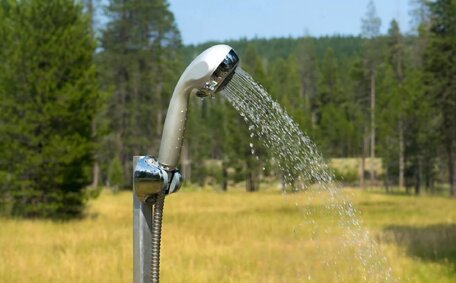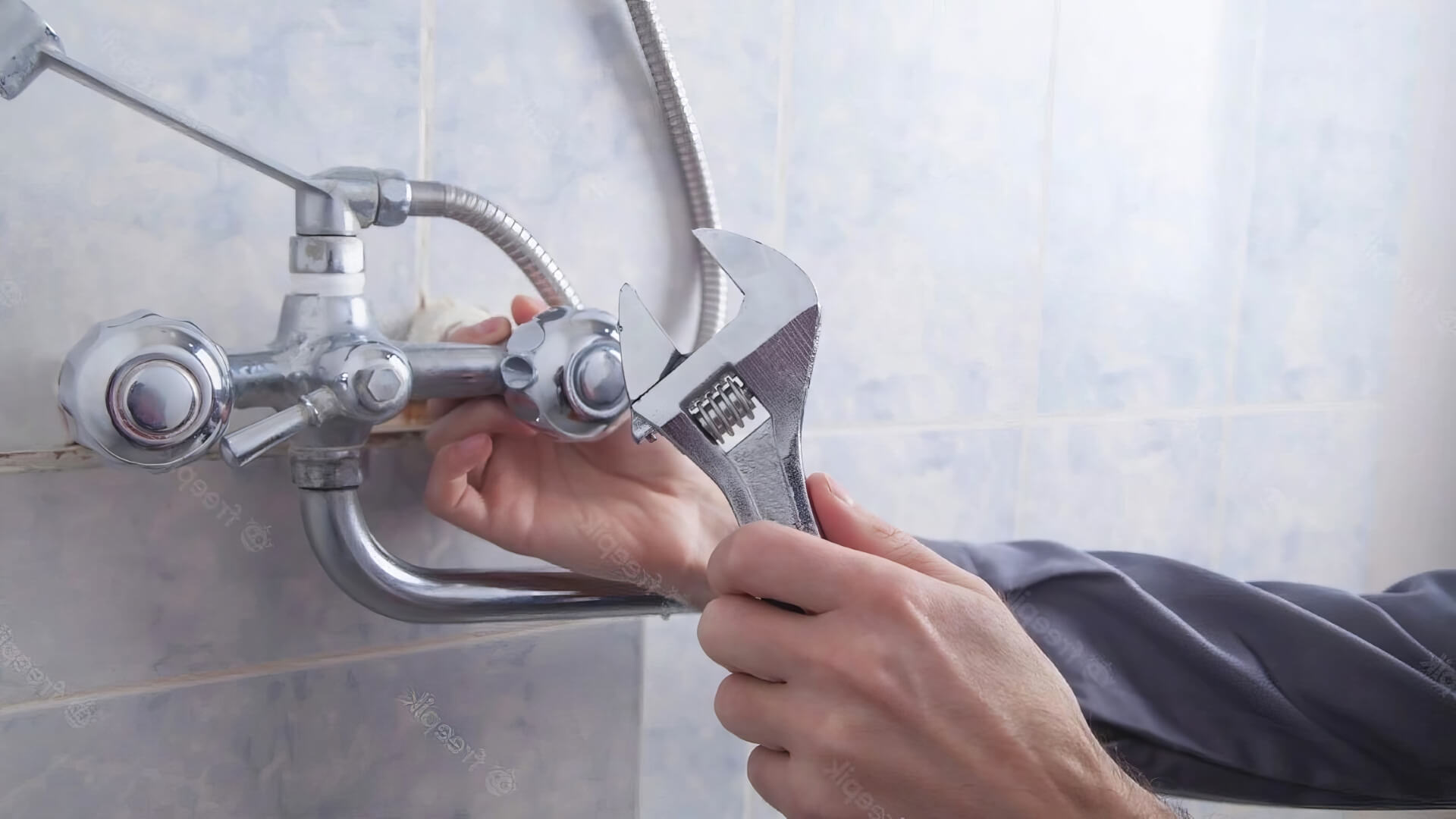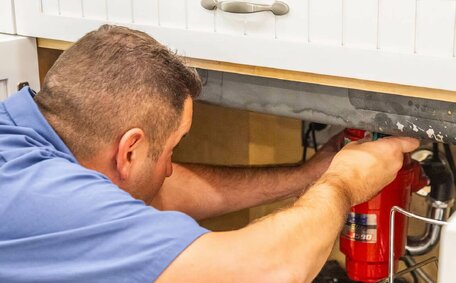Common Toilet Noises and What They Mean
Hissing
A hissing sound from your toilet typically signifies an issue with the fill valve. Toilet hissing can be one of the reasons why your toilet fill valve isn’t sealing adequately, allowing water to incessantly seep into the toilet.
This causes your toilet water to continuously fill the tank, potentially leading to flooding and higher water bills.
Gurgling
A gurgling noise when using the toilet often points to a problem with the flush valve or flapper. Located at the bottom of the tank, you’ll need to operate the flush valve to release water into the bowl when you flush.
Gurgling points to water persistently draining into the bowl, often due to a faulty flapper that doesn’t seal after flushing.
Banging Pipes
Banging noises from your pipes after flushing are often a sign of water hammer, a hydraulic shock phenomenon.
This force causes pressure spikes that can push water into the toilet bowl, creating a banging sound during flushing. Repeatedly, this can weaken your pipes’ integrity, resulting in unexpected noise issues.
Running Water
Continuous running water in your toilet usually suggests a faulty fill valve, which can cause the tank to overfill after flushing.
Hissing Toilet Noises
A hissing sound from your toilet often indicates a problem with the toilet fill valve, also known as the inlet valve or ballcock. This valve controls the noise water flow into tank whenever a flush is initiated, often preventing noisy toilet issues.
A hissing toilet typically means the fill valve isn’t closing properly after the tank fills, leading water into bowl incessantly. In this situation, continuous water flow into the tank may require valve replacement if the hissing continues, as water leaks through the refill tube into the overflow tube and toilet.
What Causes a Hissing Toilet?
The main reasons for a hissing toilet are:
- A deteriorated toilet flapper failing to establish a strong seal
- Mineral build-up prevents fill valves from closing properly, causing leaks
- A fill valve incorrectly set to a higher-than-recommended water level
- A float arm that’s misadjusted and not lifting the fill valve seal
How to Fix a Hissing Toilet
Here are the steps to troubleshoot and stop a hissing toilet:
- Begin repairs by turning off the water at the valve situated behind or nearby the toilet to ensure you turn water supply off completely before proceeding.
- Flush the toilet to evacuate the water from your toilet bowl and deplete the tank.
- Check the chain connecting the flapper and fill valve and make sure it has enough slack.
- Inspect your toilet then evaluate the top fill valve seal for any wear or mineral accumulation. Clean or replace if worn.
- Adjust the new top fill valve to ensure the water level isn’t set higher than recommended in the toilet tank.
- Check the float ball and arm and bend into proper position if needed.
- Turn the water back on and test.
- If a persistent hissing sound persists, it suggests the fill valve has decayed to the point where you’ll need to replace it.
Should you feel uncertain about these DIY solutions for your toilet’s hissing problem, or if the issue persists, it’s wise to call a licensed plumber for a comprehensive inspection and necessary replacements.
Fixing a Faulty Toilet Fill Valve
Understanding why my toilet is making irritating noises often points to a faulty toilet fill valve; fortunately, repair is usually a feasible DIY endeavour.
What You’ll Need
- Adjustable wrench
- Replacement fill valve kit
- Bucket
- Rag or towel
Follow these steps to replace the fill valve:
- Turn off the water supply behind the toilet and flush any remaining water out.
- Dry any excess moisture in the tank or toilet bowl with a cloth, managing your toilet’s water efficiently.
- Unscrew the lock nut connecting the tank to the fill valve and lift the old valve out.
- Use the accompanying instructions to install your new valve kit, screwing it back into place.
- Attach the supply line, turn on the water, and test for leaks.
- Adjust the float cup to set the appropriate water level in your tank as needed.
Dealing with problems such as a tankless water heater emitting noise involves a decision to turn off water at the home’s main water influx. Avoid delays by scheduling an appointment with our Penrith plumbing team if you are unsure about any part of the fill valve replacement process.
Adjusting the Flapper Chain
The flapper chain connects the flapper valve to the flush handle, crucial for the flushing process. Upon flushing, the chain lifts the flapper to release water into the bowl, thus preventing potential unusual sounds. If the chain becomes loose, misaligned, or overly tight over time, it may contribute to flushing issues.
Why Adjust the Flapper Chain?
A flapper chain that’s too loose may inhibit the valve from fully opening upon flushing. This may result in a weak flush, requiring multiple flushes to clear the bowl. A feeble flush may emerge, compelling you to activate the flushing mechanism every few minutes to entirely clear the bowl.
Conversely, an overly tight chain can leave the flapper valve slightly ajar, leading to a consistent trickling noise as the toilet continues to run undesirably.
How to Adjust the Flapper Chain
- Begin by shutting off the water supply using the valve located behind the toilet.
- Flush the toilet to empty all water from the tank.
- Check the current slack in the chain. You should be able to fit two fingers between the chain and flush handle arm.
- Disconnect the chain from the handle arm if it’s too loose or tight.
- Set the tank lid aside and reattach the chain to the arm, adjusting to about 1/4-inch of slack in the chain.
- Test the flushing mechanism a couple of times to ensure toilets make no excess noise and readjust as needed.
- Restore water supply and check for leaks.
Achieving the correct flapper chain tension may require our expert Penrith plumbers’ assistance. Should achieving the right tension prove elusive, don’t hesitate to give us a call; our adept Penrith plumbers are always on standby.
Banging and Hammering Noises
If your toilet produces a loud banging or hammering noise from your plumbing when flushing, the cause could be water hammer. It happens when fast-flowing water inside the pipes suddenly needs to stop or change direction.
Apart from the noticeable noise, water hammer can cause considerable damage over time. The constant pressure can strain and eventually weaken joints, potentially causing leaks and creating pounding noises within the walls. This can ultimately lead to cracks or bursts, sounds like a serious issue for your plumbing.
What Causes Water Hammer?
Common culprits behind water hammer include:
- Quick-closing valves that abruptly stop water flow in the water line
- Loose mounting of pipes enabling movement
- High water pressure supply set above 80 PSI
- Old galvanised piping
How to Prevent Water Hammer
Solutions to stop the hammering noises include:
- Installing water hammer arrestors to absorb pressure
- Replacing quick-closing with slow-closing valves
- Securing loose pipes helps prevent movement-related damage.
- Regulating water pressure via the main home shutoff valve
If you suspect water hammer issues in your plumbing, give us a chance to address it with expertise. Contact us to prevent pipe damage and resolve noisy water flow problems.
Installing a Water Hammer Arrestor
Installing water hammer arrestors can effectively silence banging sounds that occur when the toilet is flushed. Here’s how to integrate them into your water supply pipe system to mitigate plumbing issues:
- Water hammer arrestor sized for your pipes
- Adjustable wrenches
- Thread seal tape
- Identify the trouble areas in your plumbing causing sound after the water flow ceases. Arrestors work best closest to source.
- Shut off main water supply and drain the pipes.
- Cut into the line and install a tee fitting the same diameter as the pipe.
- Wrap threaded ends of arrestor with tape and screw into tee opening.
- Test by turning taps on and off. Hammering should stop.
Our licenced Penrith plumbers can properly size and place arrestors to quiet water hammer noises and prevent pipe damage throughout your plumbing system.
Gurgling Sounds and Clearing Blockages
Gurgling Noises from Blocked Drains
If your toilet emits a gurgling sound during or after flushing, it likely signals a partial blockage in the waste pipe or sewer drain. When water attempts to pass through a narrowed pipe or one filled with debris, it creates air bubbles that cause those loud gurgling sounds.
Clearing Clogged Drains
Gurgling noises indicate there is a partial clog allowing some water flow. However, If left unattended, the accrued detritus will form a complete blockage, and your loo will most likely continue producing troubling noises. Taking steps to clear obstructions is important to prevent backups and flooding.
Methods to clear a clogged toilet drain include:
- Plunging - Use a toilet plunger to forcibly push through and dislodge clogs.
- Snaking - Feed a motorised drain snake down the pipe to break up stubborn blockages.
- Chemicals - Pour a commercial clog remover product down the toilet to dissolve obstructions.
For significant drain obstructions clogging your toilet cistern or deeper sewer line challenges, engaging a licensed plumber ensures expert drain cleaning and repair services.
Snaking the Drain
When faced with the unsettling sounds of gurgling bubbling from a stubborn clog, if plunging and chemicals fail, employing a plumber’s snake is your next DIY step before seeking professional help. This flexible steel cable feeds down into pipes to break up and hook debris forcing a blockage.
When to Use a Closet Auger
Try snaking your toilet specifically when you have:
- A partial clog allowing some water flow
- Tried plunging multiple times without success
- Poured drain cleaners into the bowl without clearing the clog
Using an auger before a total blockage occurs offers the best chance to clear the clog.
How to Snake a Toilet
Adhere to these precautionary measures when toilet repairs are required:
- Insert the metal end into the toilet bowl and feed about 3 feet down the drain.
- Crank the handle clockwise while applying light downward pressure.
- When you feel resistance, keep turning the cable to work through the clog.
- Once the cable moves freely, crank it out clockwise and run hot water to flush debris.
- Avoid over-cranking to prevent pipe damage.
We don’t recommend using drain augers if you’ve never done it before. Call our licenced Penrith plumbing team if your DIY attempt fails to clear the obstruction.
When to Call a Professional Plumber
While some toilet noises and issues can be addressed with DIY troubleshooting, there are certain scenarios that require professional help. As licenced plumbers, our Penrith team has the specialised skills and tools to properly diagnose and repair your toilet.
Call Us If You Have:
- A completely clogged toilet that plunging can’t clear
- A suspected blockage deeper in the main sewer drain
- Signs of leaks from tank cracks or loose fittings
- An overflowing toilet that floods your bathroom
- Low flush power indicating an internal obstruction
- Inability to stop constant tank or bowl refilling
- Ongoing banging noises likely from water hammer
Our technicians carry video inspection equipment to accurately locate drain blocks and pipe issues. We also utilise specialised techniques, much like websites use cookies to improve experience, and can replace any deteriorated toilet components and fine-tune mechanisms to stop noises.
For prompt attention from qualified Penrith plumbers, call 1300 349 338 or email jobs@penrithplumbingservices.com.au to schedule a service appointment.
Preventative Toilet Maintenance
Regular maintenance is essential for preventing unforeseen toilet noises or leaks. A well-maintained toilet is less likely to produce disruptive noises.
Inspect Annually
Do a thorough inspection of all toilet components once a year. Check inside the tank and bowl for cracks, leaks, or mineral buildup. Ensure the chain, flapper, fill valve, and seals are in good working order.
Replace any worn parts.
Clean the Tank and Bowl
Give the tank and bowl a deep clean at least twice per year. Scrub mineral deposits and use a cleaner to dissolve hard water buildup. Clean the jets and drainage holes under the rim with a specialised toilet brush.
Check the Flush Mechanism
Test the flushing mechanism every month. Ensure a thorough flush, verify correct water levels in the tank after flush, and check that all elements cease operation as they should. Adjust as needed.
Unclog Small Blockages
Don’t allow buildup in the drain. Use a plunger or auger monthly to clear hair, soap scum, or any small clogs before they grow into major blockages.
Following these simple preventative measures can help you avoid frequent toilet noise issues. But if problems do arise or tasks seem too difficult, call our licenced plumbers for professional assistance.






